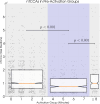Using trauma video review to search for the Goldilocks pre-activation time
- PMID: 39687555
- PMCID: PMC11647353
- DOI: 10.1136/tsaco-2024-001588
Using trauma video review to search for the Goldilocks pre-activation time
Abstract
Objectives: We sought to determine the optimal time to pre-activation for trauma team activation that resulted in maximum team efficiency, measured by the time to complete critical actions (TCCAs) during resuscitation. We hypothesized that there exists a time window for trauma team pre-activation that minimizes TCCA.
Methods: This is an exploratory retrospective analysis of video-reviewed traumas at a level 1 trauma center from January 1, 2018 to 28 February, 2022 that received the highest trauma team activation and had a pre-arrival notification. A total of 11 TCCA categories were calculated using video timestamps. To compare TCCAs from different categories, normalized TCCAs (nTCCAs) were calculated by dividing each TCCA by the median time of its category. Pre-activation times were categorized into three groups: long pre-activation (≥8 min), mid pre-activation (≥4 and ≤7 min), and short pre-activation (≥0 and ≤4).
Results: There were 466 video-recorded level 1 trauma activations, which resulted in 2334 TCCAs. Of the 466 activations, 152 occured on the patient's arrival (0 min pre-activation). The majority (425) of patients had a pre-activation time of <7 min. Pre-activation of 4-6 min resulted in all but blood transfusion TCCAs being <15 min. Furthermore, mid pre-activation category corresponded to the most efficient trauma teams, with nTCCAs significantly shorter (median=0.75 (IQR 0.3-1.3)) than long (median=1 (IQR 0.6-2)) or short activation groups (median=1 (IQR 0.6-1.6)). A greater proportion of nTCCAs were shorter than their category median in the mid pre-activation category compared with long and short categories (59.1% vs 48.3% and 40%, respectively; p<0.01).
Conclusions: In this exploratory study, a pre-activation time of 4-7 min is associated with the best team efficiency as measured by TCCAs during trauma team activations. This timeframe may be an optimal window for trauma team activations but needs prospective and external validation.
Level of evidence: Level 4 retrospective exploratory study.
Keywords: emergency medical services; emergency treatment; video.
Copyright © Author(s) (or their employer(s)) 2024. Re-use permitted under CC BY-NC. No commercial re-use. See rights and permissions. Published by BMJ.
Conflict of interest statement
None declared.
Figures





Similar articles
-
Evaluating the impact of pre-hospital trauma team activation criteria.CJEM. 2023 Dec;25(12):976-983. doi: 10.1007/s43678-023-00604-0. Epub 2023 Nov 8. CJEM. 2023. PMID: 37938515
-
Smartphone application alerts for early trauma team activation: Millennial technology in healthcare.Surgery. 2022 Feb;171(2):511-517. doi: 10.1016/j.surg.2021.05.047. Epub 2021 Jun 29. Surgery. 2022. PMID: 34210527
-
Performance in Trauma Resuscitation at an Urban Tertiary Level I Pediatric Trauma Center.Pediatr Emerg Care. 2016 Nov;32(11):756-762. doi: 10.1097/PEC.0000000000000942. Pediatr Emerg Care. 2016. PMID: 27811534
-
Trauma faculty and trauma team activation: impact on trauma system function and patient outcome.J Trauma. 1999 Sep;47(3):576-81. doi: 10.1097/00005373-199909000-00028. J Trauma. 1999. PMID: 10498319
-
Trauma Team Activation: Accuracy of Triage When Minutes Count: A Synthesis of Literature and Performance Improvement Process.J Trauma Nurs. 2019 Jul/Aug;26(4):208-214. doi: 10.1097/JTN.0000000000000450. J Trauma Nurs. 2019. PMID: 31283750 Review.
Cited by
-
Traffic Patterns and Emergency Medical Services Prenotification Transport Estimates in Trauma Activations [Response to Letter].Open Access Emerg Med. 2025 Feb 25;17:149-150. doi: 10.2147/OAEM.S520503. eCollection 2025. Open Access Emerg Med. 2025. PMID: 40027951 Free PMC article. No abstract available.
-
Impact of Traffic Patterns on Trauma Response Prenotification [Response to Letter].Open Access Emerg Med. 2025 Feb 3;17:63-64. doi: 10.2147/OAEM.S517871. eCollection 2025. Open Access Emerg Med. 2025. PMID: 39927299 Free PMC article. No abstract available.
References
-
- Elm E von, Altman DG, Egger M, Pocock SJ, Gøtzsche PC, Vandenbroucke JP. Strengthening the reporting of observational studies in epidemiology (STROBE) statement: guidelines for reporting observational studies. BMJ . 2007;335:806–8. doi: 10.1136/bmj.39335.541782.AD. - DOI - PMC - PubMed
LinkOut - more resources
Full Text Sources
Research Materials
